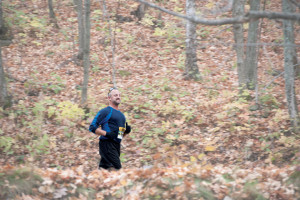Profit through Patience
- Share
- Tweet
- Pin
- Share

The Door County Triathlon didn’t produce a dime for the Door County YMCA or Door County Parks System in 2005, its first year.
The event was staged at Frank Murphy County Park and used other county park system facilities. The YMCA provided support, promotion, and dozens of volunteers. But after all was said and done, the massive undertaking was a financial wash, raising questions for the Y.
“We weren’t necessarily getting the money back for the time and effort we were putting into it,” said Cindy Weber, the Y’s financial development director.
Sean Ryan, the event’s director, said there was a lot of skepticism.

Sean Ryan
“That was a real source of tension early on with the triathlon,” he said. “There was frustration from the triathlon board, from the community, and the nonprofits. I had to make a personal loan to the event in the first year because it had negative cash flow. I believed in it, but if you would have judged it after one year, it was not successful. People were asking me why they should be donating all this time and effort for so little return.”
But when the event was launched Ryan, who also directs the Fall 50, Door County Century Ride, and the Cellcom Green Bay Marathon, urged the partnering nonprofits to have patience and a long-term vision.
It took a lot of convincing to keep the community and nonprofits on board, and in 2009 they saw that persistence pay off when the triathlon donated $20,000 each to the Y and the Friends of the Door County Parks System. In 2010, that figure jumped to $25,000 each.
“It would have been really easy to bail on the event in those early years,” Weber said. “But now we’re really seeing the benefits.”
The triathlon may be the biggest, but it’s just one of the many silent sports events that, in addition to their health and economic impacts, have become integral components of nonprofit fundraising in recent years. All told, the peninsula’s runs and rides brought in over $135,000 for nonprofits in 2010, a figure growing rapidly as new races sprout up and directors find innovative ways to incorporate fundraising into professionally–run events.
Ironically, race directors are increasingly finding that in order to generate money for nonprofits, organizers do best by taking the focus off the cause.
“The fact that these events are benefitting charities is definitely meaningful to the community,” Ryan said. “But in my experience, it’s not particularly important to most of the participants. I’m very cynical about participant concern for charity. If I ask a participant after the event, ‘Who did it benefit?’ Most would get it wrong.”
That’s why Ryan and race directors around the country say that if you want to do the most good for the charity, you must first and foremost create a high quality event.
“You have to be sure that your first priority is satisfying the audience,” Ryan said. “Some events are kind of hokey and people say, ‘It’s OK because it benefits a good cause.’ But those events don’t grow and often don’t survive. This is a finicky, unforgiving audience. For the vast majority of runners, the top concern is the race experience.”
Participants sacrifice hundreds of hours and spend hundreds or thousands of dollars training and traveling for an event, and if it doesn’t meet their high standards, they won’t be back, no matter how much they believe in the cause.
Like the triathlon, the Door County Half Marathon has steadily grown its contributions to Door County charities since it was first run in May of 2008, but not because of a close association with any one cause or a particular emphasis on fundraising. Contributions have grown because the event has earned a reputation as a great race and attracted more participants, including those who have joined its Run for A Cause program, launched in 2010.
That program makes free race registrations available for participants who raise at least $250 for a Door County nonprofit. David Eliot, one of the half marathon’s founders, said it’s another step toward achieving the larger goals of the event.
“We launched the half marathon as a community event, something to celebrate everything that’s great about Door County,” he said. “Of course that includes Peninsula State Park and our incredible natural resources, but it’s also about the people and supporting the nonprofits that are such a big part of the social fabric here.”
In 2010 the program brought in $6,300 for area nonprofits, a number that Eliot expects to soar in years to come. That was in addition to more than $3,700 that went to nonprofits for running aid stations and other contributions.
It took three years of solidifying the status of the half marathon and establishing it as a marquee event before organizers expanded charitable efforts. Ryan said that is the type of planning model nonprofits should expect to follow in creating successful events.
“It’s not great fundraising in the short run,” Ryan said. “These events tend to have a long-term payoff for communities and charitable organizations. Like any business, if you’re not willing to tough it out in the first couple years you’ll never make it to the point where you’ll see the benefits.”
It’s hard to sell nonprofits on events that don’t generate immediate returns. Most nonprofits exist in a world of perpetual fundraising, where meeting the current year’s budget needs, or even the current month’s, is priority number one. Donors want to see their dollars go directly to a cause, rarely appreciating the need to build long-term organizational strength or hire quality people to carry out the mission.
Nonprofit directors get precious little allowance to develop long-range forecasting and planning, as grant cycles and government reporting force them to operate on a year-to-year basis, and show immediate returns for the cause to justify expenses.
“Most charities look at all decisions on a 12-month cycle, not five years,” Ryan said. “Their granting and budgets are done on 12 months, so if you come to them with a proposal and ask them to look at results in five years, they’ll say you’re crazy.”
Last year one of the oldest events on the peninsula’s silent sports event calendar decided to change to revamp its organization. The Ride for Nature to Benefit The Ridges Sanctuary has been raising funds for the nature preserve’s educational programs for more than two decades. Run by Ridges staff and volunteers, the event usually attracted about 300 riders each June. In 2010, The Ridges turned over management of the event to the Peninsula Pacers, the organization that founded the Door County Half Marathon, in hopes of growing the event and the amount it raises for The Ridges.
Nearly 400 riders took part in last year’s ride, and $8,000 was raised for The Ridges Sanctuary. Peninsula Pacers co-founder Brian Fitzgerald is excited about the ride’s future prospects.
“We feel that there is a lot of room for growth with this event,” Fitzgerald said. “It can bring in more money to The Ridges, and we think we can also tie it into the Baileys Harbor community more and use it as a promotional piece to bring new people to Door County.”
While Fitzgerald still uses the event as a way to promote and tell the story of The Ridges Sanctuary, a greater emphasis is now placed on the ride itself, specifically the addition of a 100-mile route last year to pique the interest of serious riders looking for a physical challenge, as well as post-race activities in Baileys Harbor and tie-ins with Ephraim’s annual Fyr Bal Festival the same weekend.
“Participants want a complete experience,” Fitzgerald said. “They want to be entertained, and they’re looking for things to do beyond the event itself, which is great for businesses and the larger community. We want to connect them to that.”
That type of connection is what the Hairpin Run has to July 4th traditions in Fish Creek. Each Independence Day starts the same in the center of town. Early in the morning over a thousand revelers, many local but most from out of town, gather at the bottom of the Fish Creek hill in the center of the village. When the starting gun sounds, they begin the arduous trudge up the winding hill, only to be rewarded with a challenging descent around the hairpin turn when they hit Cottage Row. When it’s over, the run brings in about $18,000 annually for Friends of Gibraltar (FOG) programming at Gibraltar School in Fish Creek.
Most of the runners likely don’t know where the money goes, but thanks to the race’s success and the support of its sponsors, FOG is able to provide enrichment programming for Northern Door students every year. That programming includes artist-in-residence programs and this year’s Spanish literacy celebration, as well as productions at the Door Community Auditorium.
FOG’s theme for the 2010-2011 school year is Door County History, which included the “Garments of our Foundation” exhibit at the Link Gallery of the Door Community Auditorium. That exhibit, coordinated by Kärin Kopischke of Peninsula Players, told the story of 10 pioneering Door County women.
Kopischke’s artist-in-residence program with students in grades eight and nine partnered with social studies classes to create historical renderings of a person in their family or from Door County history from the 1800s. Students researched the life of the person, then wrote a first-person narrative and drew sketches of the person to add to the exhibit.
“We definitely wouldn’t have been able to do that, or a lot of what we do, without the Hairpin Run,” said FOG coordinator Vinni Chomeau.
And she said they would be able to do put the run together without the support of its sponsors, like the Door County Confectionery, which has been a big supporter of the Hairpin.
“They help us cover our organizational costs – that includes t-shirts, medals, prizes – allowing us to put all the registration funds to the cause,” Chomeau said.
Door County Confectionery owner Kurt Doman said his business certainly benefits from its sponsorship of the race, but it’s important to him to support Fish Creek as well as FOG and its educational programs.
“We own the Founder’s Square property, so we wanted to do something in Fish Creek,” he said. “But we also want to be supportive of any event that gets people out and exercising. I do the Door County Triathlon, and we’ve had 15 to 20 family members participating in the Hairpin Run every year.”
There’s a personal side to their support as well. Kurt’s mother and the confectionery’s founder, Judith Doman, passed away two years ago. Since then, the event has become even more important for his family.
“She loved having everyone together each year, so it has become pretty nostalgic for us,” he said.
Northern Door YMCA Relationship Development Manager Matt Luders said that these silent sports events do more than bring in much-needed dollars. For the Y, they help fulfill its purpose and connect with the community.
“It fits our mission to a tee, because it encourages people to get active,” he said. “These events give us a chance to tell our story and the stories of our members. It’s great publicity, and it’s inspiring to others.”
Weber said the growth of endurance events in Door County has served as a catalyst for people to change their habits and live healthier lifestyles.
“We’ve seen an unbelievable amount of people come to the Y to train for these events,” Weber said. “We see them swimming in the pool, running laps, and changing their lives. You never know what’s going to inspire someone to make a change, but a lot of people need a goal and these give them that. It’s made a big difference in a lot of lives.”
The Y also sponsors the Blossom Run in Egg Harbor each spring, which Weber said isn’t as much about fundraising as it is about providing a goal for members and a reminder to get outside again.
“We want to offer a schedule of programs to promote health and wellness throughout the year,” Weber said, “to give people something to train for and get outside. It shows in a very public way how the Y helps people live a healthier lifestyle.”
Whether they’re aware of it or not, whether their reasons for running are personal or altruistic, the participants who are fueling the tremendous support and rapid growth of Door County runs and rides are doing more than getting exercise. With each year, they’re helping send more much-needed funds to the nonprofits of the Door Peninsula.

